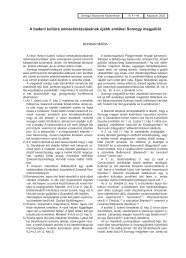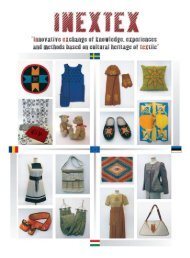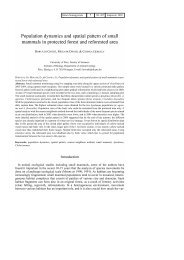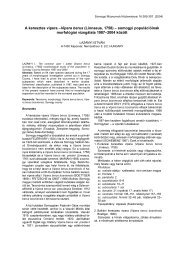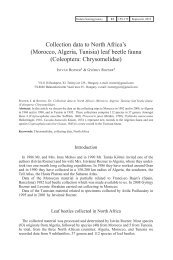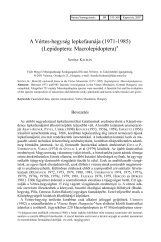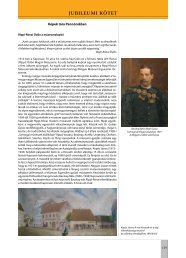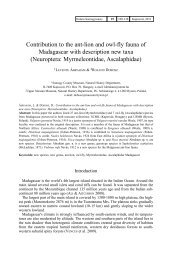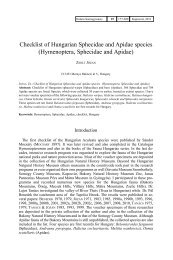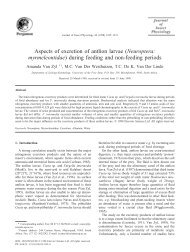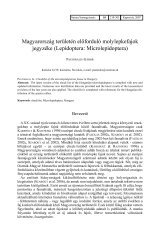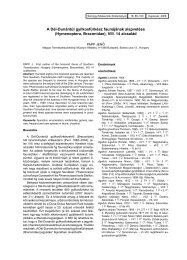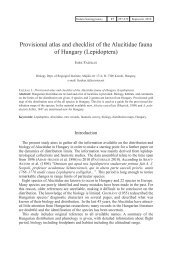Study on the Palaearctic Pristiphora species (Hymenoptera ...
Study on the Palaearctic Pristiphora species (Hymenoptera ...
Study on the Palaearctic Pristiphora species (Hymenoptera ...
You also want an ePaper? Increase the reach of your titles
YUMPU automatically turns print PDFs into web optimized ePapers that Google loves.
HARIS A.: STUDY ON THE PALAEARCTIC PRISTIPHORA SPECIES<br />
221<br />
12. Apex of hind tibia and hind tarsus black [Corners of pr<strong>on</strong>otum, tegula yellowish.<br />
Inner spur of hind tibia half as l<strong>on</strong>g as basitarsus. Only tegula and labrum yellow. Stigma<br />
darker than costa.] 5.0 mm. Fig. 205...................................................P. basidentalia Wei<br />
Known <strong>on</strong>ly from China.<br />
- Legs light coloured, <strong>on</strong>ly last segments of middle and hind tarsi darker. 5.5 mm.<br />
[Black, labrum, small spot <strong>on</strong> malar space, tegula yellowish. Propodeum frequently with<br />
lateral 2 or 4 small maculae.]....................................................................P. ribisi Togashi<br />
Known <strong>on</strong>ly from Japan (H<strong>on</strong>shu).<br />
13. Claws bifid............................................................................................................14.<br />
- Claws with pre-apical denticle or in <strong>on</strong>e <strong>species</strong> simple.........................................16.<br />
14. Hind legs black. Mesopleur<strong>on</strong> shiny. 4.5 mm.........................P. frigida (Boheman)<br />
Russia: Novaya Zemlya, Spitzbergen and Sweden.<br />
- Hind tibia extensively white.....................................................................................15.<br />
15. Mesopleur<strong>on</strong> shiny. Hind trochanter white. 4.0-5.0 mm. P. salicivora in Fig. 201.<br />
See also notes................................................P. bifida Hellen and P. salicivora Takeuchi<br />
P. bifida Hellén: Hungary, Czech, France, Scotland, Finland and Georgia. P. salicivora is known from Japan<br />
and Sakhalin.<br />
- Mesopleur<strong>on</strong> matt. 4.5 mm..........................................................P. amaura Lindqvist<br />
Nor<strong>the</strong>rn Finland.<br />
16. Trochanters white (in <strong>on</strong>e <strong>species</strong> light yellowish brown)...................................17.<br />
- Trochanters black.....................................................................................................25.<br />
17. Antenna ochraceous or light coloured at least below or sometimes even above...18.<br />
- Antenna black...........................................................................................................21.<br />
18. Antenna ochraceous..............................................................................................19.<br />
- Antenna light coloured below...................................................................................20.<br />
19. Saw with rows of bristles from <strong>the</strong> 6th-8th denticle. 4.0-4.5 mm. Serrulae in Fig.<br />
175. [Black. Labrum mostly light coloured. Tegula and sometimes pr<strong>on</strong>otal corners light<br />
coloured. Antenna reddish brown, dorsally black. Legs whitish, basal half of fore and<br />
middle femora, bases of coxae, more or less black. Hind femora entirely black. Apex of<br />
hind tibia black. Fr<strong>on</strong>tal area not marked. Wings hyaline, stigma brown with lighter<br />
lower margin.]................................................................................P. ruficornis (Olivier)<br />
All Europe, Russia including Crimea, Caucasus, Siberia, <strong>the</strong> Trans Baikal and M<strong>on</strong>golia.<br />
- Saw with rows of bristles from <strong>the</strong> 4th denticle (Fig. 176). 4.0-5.5 mm. [Black.<br />
Labrum mostly light coloured. Tegula and hind margin of pr<strong>on</strong>otum light coloured.<br />
Antenna reddish brown, dorsally black. Legs whitish, basal half of fore and middle<br />
femora, bases of coxae more or less black. Hind femur entirely black. Apex of hind tibia<br />
black. Fr<strong>on</strong>tal area not marked. Wings hyaline, stigma yellowish brown.]<br />
........................................................P. armata (Thoms<strong>on</strong>) ( syn. P. crassicornis Hartig)<br />
Middle, Western and Eastern Europe, Scandinavia, Asia Minor and Russia: including <strong>the</strong> Nor<strong>the</strong>rn<br />
Caucasus, South Siberian mountains, Kamtchatka and Sakhalin.<br />
20. Head and thorax densely punctuate, matt. 5.0 mm......................P. opaca Lindqvist<br />
Belgium and Finland.<br />
- Punctuati<strong>on</strong> ra<strong>the</strong>r sparse. 5.0 mm. Saw in Fig. 179....................P. c<strong>on</strong>fusa Lindqvist<br />
Hungary, Belgium, Switzerland, Germany, France, England, Scotland, Slovakia, Ne<strong>the</strong>rlands, Ukraine,<br />
Slovakia, Russia: Karelia, Sweden and Finland.<br />
21. Stigma and costa extremely light whitish pale brown, transparent, subhyaline.<br />
Tegula yellowish white. 5.0 mm.....................................................P. subopaca Lindqvist<br />
Germany, England, Scotland, Norway, Sweden and Finland.<br />
- Stigma brown-light brown, costa light brown. Never transparent subhyaline..........22.<br />
22. Claws simple. First cubital crossvein missing. 3.7 mm. [Body black, including



